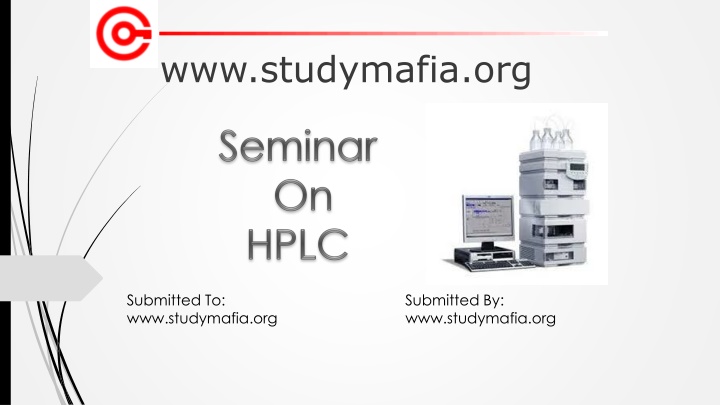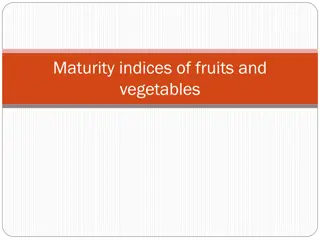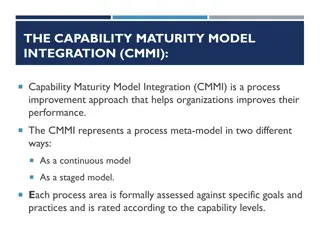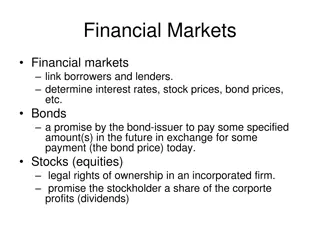Project Management Maturity Presentation Template
Use this customizable template for project management maturity presentations within your organization. Tailor the slides for a five-level or four-level model, add notes, and integrate your logo. Present levels 5 to 1 with key points and bulletins. Disclaimer: Information provided is for reference only, and reliance on it is at your own risk.
Download Presentation

Please find below an Image/Link to download the presentation.
The content on the website is provided AS IS for your information and personal use only. It may not be sold, licensed, or shared on other websites without obtaining consent from the author.If you encounter any issues during the download, it is possible that the publisher has removed the file from their server.
You are allowed to download the files provided on this website for personal or commercial use, subject to the condition that they are used lawfully. All files are the property of their respective owners.
The content on the website is provided AS IS for your information and personal use only. It may not be sold, licensed, or shared on other websites without obtaining consent from the author.
E N D
Presentation Transcript
www.studymafia.org Submitted To: www.studymafia.org www.studymafia.org Submitted By:
Table of Content How it Looks Introduction Principle of HPLC Instrumentation pf HPLC Types of HPLC Comparison of HPLC with different Chromatography Why We use HPLC Applications Advantages Limitation References
Introduction High performance liquid chromatography or commonly known as HPLC is an analytical technique used to separate, identify or quantify each component in a mixture. The mixture is separated using the basic principle of column chromatography and then identified and quantified by spectroscopy. In the 1960s the column chromatography LC with its low- pressure suitable glass columns was further developed to the HPLC with its high-pressure adapted metal columns. HPLC is thus basically a highly improved form of column liquid chromatography. Instead of a solvent being allowed to drip through a column under gravity, it is forced through under high pressures of up to 400 atmospheres.
Principle The purification takes place in a separation column between a stationary and a mobile phase. The stationary phase is a granular material with very small porous particles in a separation column. The mobile phase, on the other hand, is a solvent or solvent mixture which is forced at high pressure through the separation column. Via a valve with a connected sample loop, i.e. a small tube or a capillary made of stainless steel, the sample is injected into the mobile phase flow from the pump to the separation column using a syringe.
Cont... Subsequently, the individual components of the sample migrate through the column at different rates because they are retained to a varying degree by interactions with the stationary phase. After leaving the column, the individual substances are detected by a suitable detector and passed on as a signal to the HPLC software on the computer. At the end of this operation/run, a chromatogram in the HPLC software on the computer is obtained. The chromatogram allows the identification and quantification of the different substances.
Instrumentation of High-Performance Liquid Chromatography (HPLC) The Pump Injector Column Detector Recorder Degasser Column Header
The Pump The development of HPLC led to the development of the pump system. The pump is positioned in the most upper stream of the liquid chromatography system and generates a flow of eluent from the solvent reservoir into the system. High-pressure generation is a standard requirement of pumps besides which, it should also to be able to provide a consistent pressure at any condition and a controllable and reproducible flow rate. Most pumps used in current LC systems generate the flow by back- and-forth motion of a motor-driven piston (reciprocating pumps). Because of this piston motion, it produces pulses .
Injector An injector is placed next to the pump. The simplest method is to use a syringe, and the sample is introduced to the flow of eluent. The most widely used injection method is based on sampling loops. The use of the autosampler (auto-injector) system is also widely used that allows repeated injections in a set scheduled-timing.
Column The separation is performed inside the column. The recent columns are often prepared in a stainless steel housing, instead of glass columns. The packing material generally used is silica or polymer gels compared to calcium carbonate. The eluent used for LC varies from acidic to basic solvents. Most column housing is made of stainless steel since stainless is tolerant towards a large variety of solvents.
Detector Separation of analytes is performed inside the column, whereas a detector is used to observe the obtained separation. The composition of the eluent is consistent when no analyte is present. While the presence of analyte changes the composition of the eluent. What detector does is to measure these differences. This difference is monitored as a form of an electronic signal. There are different types of detectors available.
Recorder The change in eluent detected by a detector is in the form of an electronic signal, and thus it is still not visible to our eyes. In older days, the pen (paper)-chart recorder was popularly used. Nowadays, a computer-based data processor (integrator) is more common. There are various types of data processors; from a simple system consisting of the in-built printer and word processor while those with software that are specifically designed for an LC system which not only data acquisition but features like peak-fitting, baseline correction, automatic concentration calculation, molecular weight determination, etc.
Degasser The eluent used for LC analysis may contain gases such as oxygen that are non-visible to our eyes. When gas is present in the eluent, this is detected as noise and causes an unstable baseline. Degasser uses special polymer membrane tubing to remove gases. The numerous very small pores on the surface of the polymer tube allow the air to go through while preventing any liquid to go through the pore.
Column Heater The LC separation is often largely influenced by the column temperature. In order to obtain repeatable results, it is important to keep consistent temperature conditions. Also for some analysis, such as sugar and organic acid, better resolutions can be obtained at elevated temperatures (50 to 80 C). Thus columns are generally kept inside the column oven (column heater).
BLOCK DIAGRAM OF HPLC 18 Reservoir Reservoir Recorder Pump Gradient controller Pump Detector Fraction collector Analytical column Mixing chamber Solvent Conditioning column Injector Precolumn
Types of High-Performance Liquid Chromatography (HPLC) Normal phase Reverse phase Ion exchange Size exclusion
Normal phase: This method separates analytes on the basis of polarity. NP-HPLC uses polar stationary phase and non-polar mobile phase. Therefore, the stationary phase is usually silica and typical mobile phases are hexane, methylene chloride, chloroform, diethyl ether, and mixtures of these. Polar samples are thus retained on the polar surface of the column packing longer than less polar materials.
Reverse Phase HPLC The stationary phase is nonpolar (hydrophobic) in nature, while the mobile phase is a polar liquid, such as mixtures of water and methanol or acetonitrile. It works on the principle of hydrophobic interactions hence the more nonpolar the material is, the longer it will be retained.
Ion-Exchange HPLC The stationary phase has an ionically charged surface of opposite charge to the sample ions. This technique is used almost exclusively with ionic or ionizable samples. The stronger the charge on the sample, the stronger it will be attracted to the ionic surface and thus, the longer it will take to elute. The mobile phase is an aqueous buffer, where both pH and ionic strength are used to control elution time.
Size-exclusion HPLC The column is filled with material having precisely controlled pore sizes, and the particles are separated according to its their molecular size. Larger molecules are rapidly washed through the column; smaller molecules penetrate inside the porous of the packing particles and elute later.
COMPARISION BETWEEN HPTLC AND HPLC Sr.no. HPTLC HPLC 1 High Chromatography Performance Thin Layer High Performance Liquid Chromatography 2 Column Chromatography Planar Chromatography Principle Chromatography based on 3 Adsorption Principle is based on Adsorption and Partition Chromatography 4 Simultaneous method for test as well as reference material Not simultaneous method for test as well as reference material 5 It is simple, rapid, reproducible method It is Tedious method 6 Sample preparation is simple Sample preparation is complex 7 Limited Flexibility Extreme Flexibility Automatic (Instrumental) Technique 8 SemiautomaticTechnique 59 9 Determination of SurfaceArea Determination of Retention Time
COMPARISION BETWEEN GC AND HPLC SR.NO. GC HPLC 1 Gas Chromatography High Performance Liquid Chromatography High resolution Extreme Flexibility Determination of Volatile and Non Volatile Compounds 2 3 4 Less resolution Limited Flexibility Determination of Volatile compounds 60
COMPARISION BETWEEN HPLC AND UPLC Parameters HPLC Assay UPLCAssay Column XTerra,C18,50 4.6mm AQUITY UPLC BEH C18,50 2.1mm Particle size 4 m particles 1.7 m particles Flow rate 3.0 ml per min 0.6 ml per min Injection volume 20 l 3 l partial loop fill or 5 l full loop fill Total run time 10 min 1.5 min 2000 7500 Theoretical Plate count 61
Parameters HPLC Assay UPLC Assay 0.2 g/ml 0.054 l/ml Lower limit of quantization Total solvent consumption Delay volume Acetonitrile:10.5ml, water:21ml 720 l Acetonitrile:0.53ml, water:0.66ml 110 l 30 C 65 C Column temperature Maximum back 35-40 Mpa less 103.5 Mpa more pressure Resolution Method development cost Less High High Low 62
WHY USE HPLC Simultaneous analysis High resolution High sensitivity Good repeatability Moderate analysis condition Easy to fractionate and purify Not destructive
Applications of HPLC The information that can be obtained by HPLC includes resolution, identification and quantification of a compound. It also aids in chemical separation and purification. The other applications of HPLC include : Pharmaceutical Applications To control drug stability. Tablet dissolution study of pharmaceutical dosages form. Pharmaceutical quality control.
Cont... Environmental Applications Detection of phenolic compounds in drinking water. Bio-monitoring of pollutants. Applications in Forensics Quantification of drugs in biological samples. Identification of steroids in blood, urine etc. Forensic analysis of textile dyes. Determination of cocaine and other drugs of abuse in blood, urine etc.
Cont. Food and Flavour Measurement of Quality of soft drinks and water. Sugar analysis in fruit juices. Analysis of polycyclic compounds in vegetables. Preservative analysis. Applications in Clinical Tests Urine analysis, antibiotics analysis in blood. Analysis of bilirubin, biliverdin in hepatic disorders. Detection of endogenous Neuropeptides in extracellular fluid of brain etc.
Advantages of HPLC Separations fast and efficient (high resolution power) Continuous monitoring of the column effluent It can be applied to the separation and analysis of very complex mixtures Accurate quantitative measurements. Repetitive and reproducible analysis using the same column. Adsorption, partition, ion exchange and exclusion column separations are excellently made.
Limitations Cost: Despite its advantages, HPLC can be costly, requiring large quantities of expensive organics. Complexity HPLC does have low sensitivity for certain compounds, and some cannot be detected as they are irreversibly adsorbed. Volatile substances are better separated by gas chromatography.
References Wikipedia Google Studymafia.org























